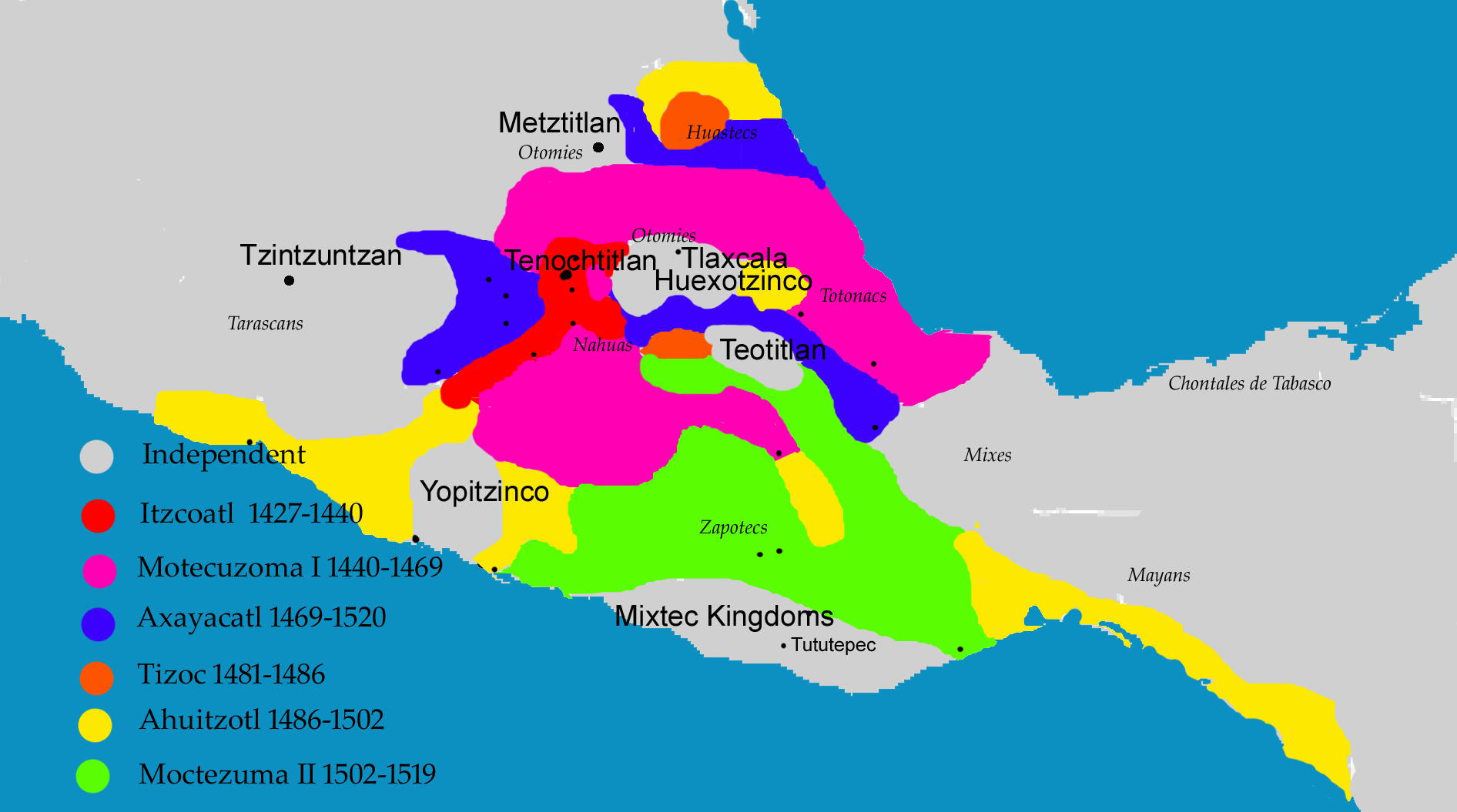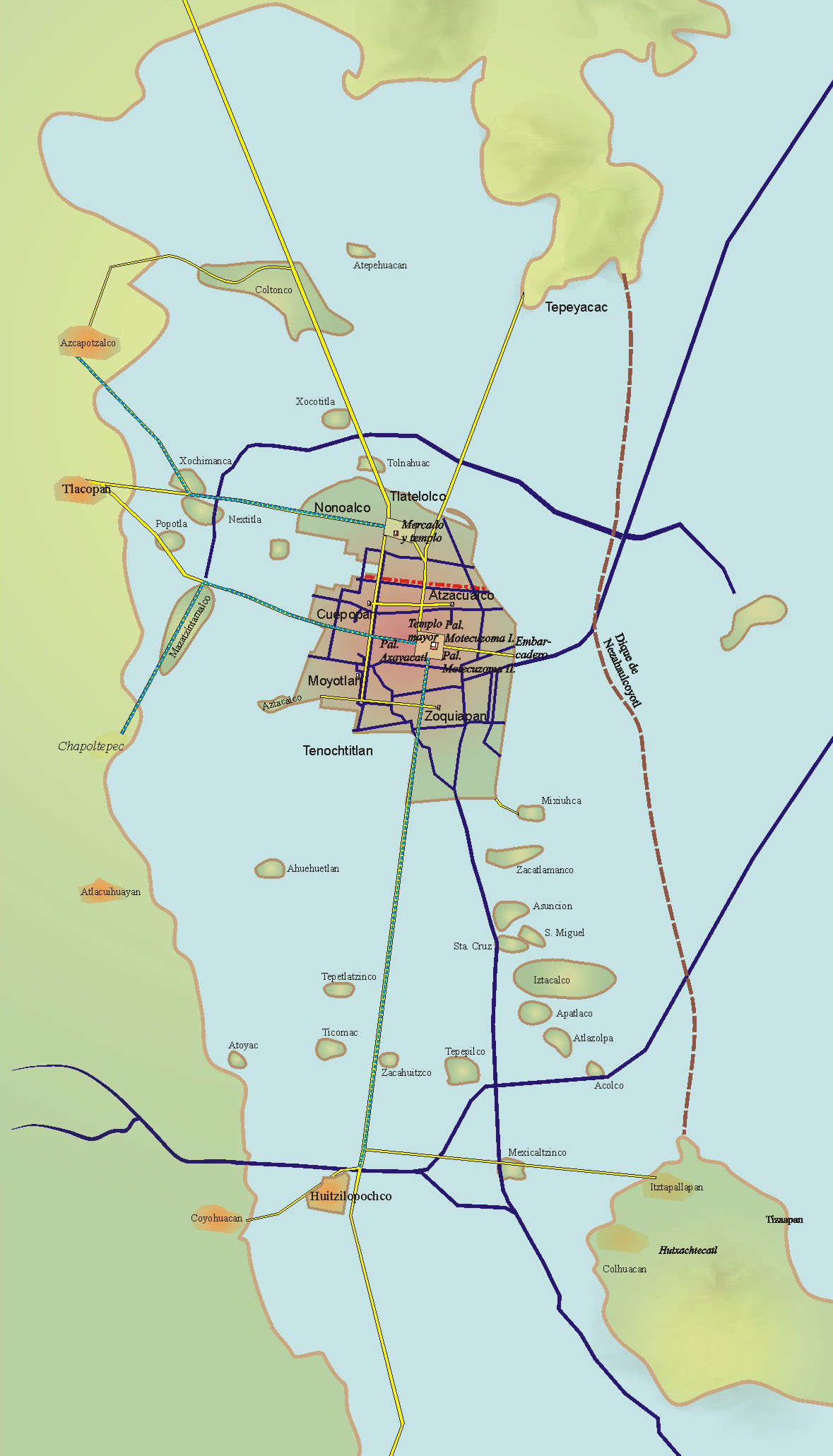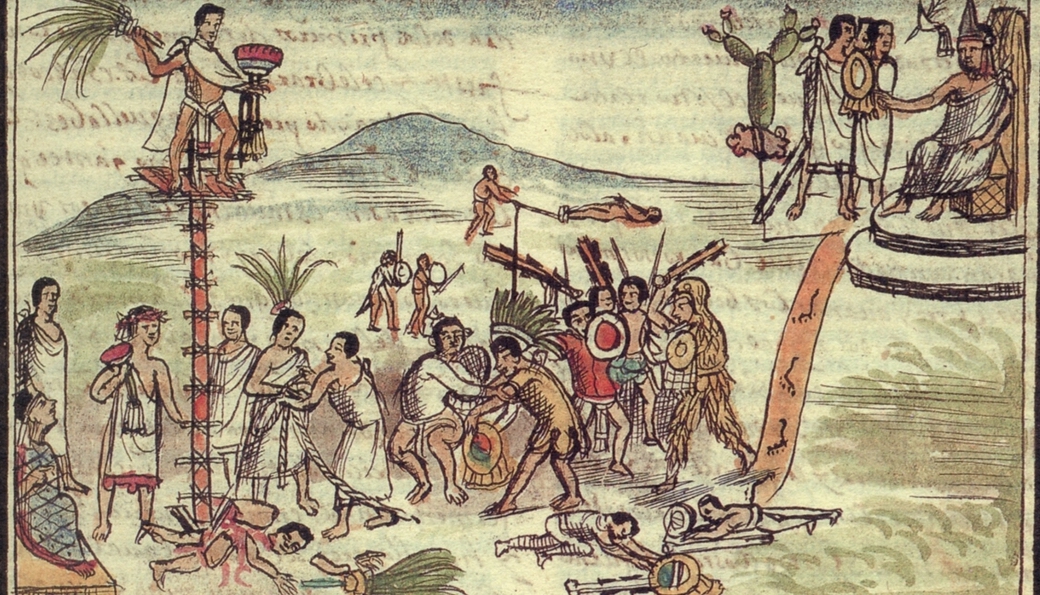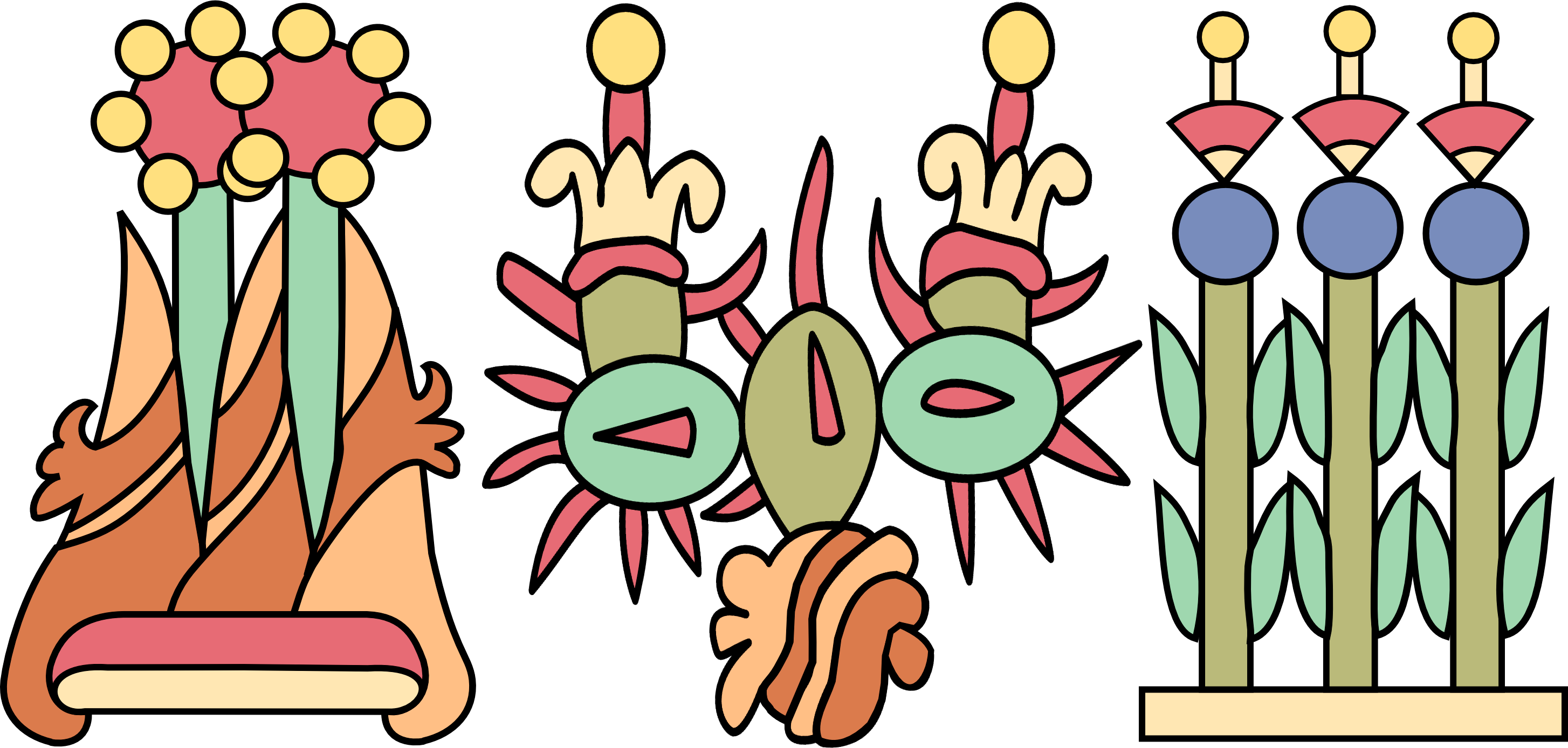|
Tezozomoc (son Of Itzcoatl)
Tezozomoctzin ( ) was a son of Itzcoatl, the fourth Aztec ruler (''tlatoani'') of Tenochtitlan. Tezozomoctzin never became ruler himself, but he was married to Atotoztli II, daughter of his cousin Moctezuma I (the fifth ruler) They had three sons that each would become rulers: Axayacatl, Tizoc, and Ahuitzotl — would become the sixth, seventh and eighth rulers, respectively. A fourth son Huitzilihuitl is listed in the genealogy, but was never ruler and has no listed children. His daughter Chalchiuhnenetzin married Moquihuix, ruler of Tlatelolco altepetl The ( , plural ''altepeme'' or ''altepemeh'') was the local, ethnically-based political entity, usually translated into English as "city-state", of pre-Columbian Nahuatl-speaking societiesSmith 1997 p. 37 in the Americas. The ''altepetl'' was .... References * {{Authority control 15th-century Aztec nobility ... [...More Info...] [...Related Items...] OR: [Wikipedia] [Google] [Baidu] [Amazon] |
Atotoztli II
Atotoztli ( ) or Huitzilxochtzin ( ) was an Aztec princess and possible regent. She was a daughter of the Aztec emperor Moctezuma I and Chichimecacihuatzin I, the daughter of Cuauhtototzin, the ruler of Cuauhnahuac. Life She married Tezozomoc, son of the previous emperor Itzcoatl, and gave birth to three sons who would later become emperors themselves: Axayacatl, Tizoc, and Ahuitzotl. Some sources indicate she served as ''tlatoani'' herself. The ''Anales de Tula'' and ''Relación de la Genealogía'' state she ruled the Triple Alliance herself, possibly for as long as 30 years. If true, the records of the Mexica may have omitted her from the records because she was a woman. On the other hand, the documents supporting these claims were not contemporary, and made on request of Juan Cano de Saavedra to support the claims of his wife Isabel Moctezuma as heiress to Tenochtitlan. She may have acted as regent for her son Ahuitzotl, who may have been too young to act as a ruler ... [...More Info...] [...Related Items...] OR: [Wikipedia] [Google] [Baidu] [Amazon] |
Axayacatl
Axayacatl (; ; ; meaning "face of water"; –1481) was the sixth of the of Tenochtitlan and Emperor of the Aztec Triple Alliance. Biography Early life and background Axayacatl was a son of the princess Atotoztli II and her cousin, prince Tezozomoc (son of Itzcoatl), Tezozomoc. He was a grandson of the Emperors Moctezuma I and Itzcoatl. He was a descendant of the king Cuauhtototzin. He was a successor of Moctezuma and his brothers were Emperors Tizoc and Ahuitzotl and his sister was the Queen Chalchiuhnenetzin. He was an uncle of the Emperor Cuauhtémoc and father of Emperors Moctezuma II and Cuitláhuac. Rise to power During his youth, his military prowess gained him the favor influential figures such as Nezahualcoyotl (tlatoani), Nezahualcoyotl and Tlacaelel I, and thus, upon the death of Moctezuma I in 1469, he was chosen to ascend to the throne, much to the displeasure of his two older brothers, Tizoc and Ahuitzotl. It is also important that the Aztec calendar stone, ... [...More Info...] [...Related Items...] OR: [Wikipedia] [Google] [Baidu] [Amazon] |
Tizoc
Tizocic (), or Tizocicatzin (), usually known in English as Tizoc, was the seventh tlatoani of Tenochtitlan, ''tlatoani'' of Tenochtitlan. His name means, "He who makes sacrifices" or "He who does penance." Either Tizoc or his successor Ahuitzotl was the first ''tlatoani'' of Tenochtitlan to assume the title ''Huey Tlatoani'' ("supreme ''tlatoani''") to make their superiority over the other cities in the Triple Alliance (Aztec Empire) clear. Biography Family Tizoc was a son of the princess Atotoztli II and her cousin, prince Tezozomoc (son of Itzcoatl), Tezozomoc. He was a grandson of Emperors Moctezuma I and Itzcoatl. He was a descendant of the King Cuauhtototzin. He was successor of his brother Axayacatl and was succeeded by his other brother, Ahuitzotl; his sister was the Queen Chalchiuhnenetzin, married to Moquihuix, tlatoani of Tlatelolco (altepetl), Tlatelōlco. He was an uncle of Emperors Cuauhtémoc, Moctezuma II and Cuitláhuac and grandfather of Diego de San Francis ... [...More Info...] [...Related Items...] OR: [Wikipedia] [Google] [Baidu] [Amazon] |
Ahuitzotl
Ahuitzotl (, ) was the eighth Aztec ruler, the '' Huey Tlatoani'' of the city of Tenochtitlan, son of princess Atotoztli II. His name literally means "Water Thorny" and was also applied to the otter. It is also theorized that more likely, the animal called ahuitzotl is actually the water opossum, the hand symbolizing its prehensile tail, which otters notably lack. Either Ahuitzotl or his predecessor Tizoc was the first ''tlatoani'' of Tenochtitlan to assume the title ''Huey Tlatoani'' ("supreme ''tlatoani''") to make their superiority over the other cities in the Triple Alliance (Aztec Empire) clear. Ahuitzotl was responsible for much of the expansion of the Mexica domain, and consolidated the empire's power after emulating his predecessor. He took power as Emperor in the year 7 Rabbit (1486), after the death of his predecessor and brother, Tizoc. He had two sons, the kings Chimalpilli II and Cuauhtémoc, and one daughter. Biography Perhaps the greatest known military lead ... [...More Info...] [...Related Items...] OR: [Wikipedia] [Google] [Baidu] [Amazon] |
Itzcoatl
Itzcoatl ( , "Obsidian Serpent", ) (c. 1380–1440) was the fourth king of Tenochtitlan, and the founder of the Aztec Empire, ruling from 1427 to 1440. Under Itzcoatl the Mexica of Tenochtitlan threw off the domination of the Tepanecs and established the Triple Alliance (Aztec Empire) together with the other city-states Tetzcoco and Tlacopan. Biography Itzcoatl was the natural son of ''tlàtoāni'' Acamapichtli and an unknown Tepanec woman from Azcapotzalco. He was elected as the king when his predecessor, his nephew Chimalpopoca, was killed by Maxtla of the nearby Tepanec ''āltepētl'' (city-state) of Azcapotzalco. Allying with Nezahualcoyotl of Texcoco, Itzcoatl went on to defeat Maxtla and end the Tepanec domination of central Mexico. After this victory, Itzcoatl, Nezahualcoyotl, and Totoquilhuaztli, king of Tlacopan, forged what would become known as the Aztec Triple Alliance, forming the basis of the eventual Aztec Empire. Itzcoatl next turned his attention ... [...More Info...] [...Related Items...] OR: [Wikipedia] [Google] [Baidu] [Amazon] |
Aztec
The Aztecs ( ) were a Mesoamerican civilization that flourished in central Mexico in the Post-Classic stage, post-classic period from 1300 to 1521. The Aztec people included different Indigenous peoples of Mexico, ethnic groups of central Mexico, particularly those groups who spoke the Nahuatl, Nahuatl language and who dominated large parts of Mesoamerica from the 14th to the 16th centuries. Aztec culture was organized into city-states (''altepetl''), some of which joined to form alliances, political confederations, or empires. The Aztec Empire was a confederation of three city-states established in 1427: Tenochtitlan, the capital city of the Mexica or Tenochca, Tetzcoco (altepetl), Tetzcoco, and Tlacopan, previously part of the Tepanec empire, whose dominant power was Azcapotzalco (altepetl), Azcapotzalco. Although the term Aztecs is often narrowly restricted to the Mexica of Tenochtitlan, it is also broadly used to refer to Nahuas, Nahua polities or peoples of central Pre ... [...More Info...] [...Related Items...] OR: [Wikipedia] [Google] [Baidu] [Amazon] |
Tlatoani
''Tlahtoāni'' ( , "ruler, sovereign"; plural ' ) is a historical title used by the dynastic rulers of (singular ''āltepētl'', often translated into English as "city-state"), autonomous political entities formed by many pre-Columbian Nahuatl-speaking peoples in the Valley of Mexico during the Postclassic Period. The title of ' (, "great ruler, emperor") was used by the rulers of the Aztec Empire, an alliance between the ''āltepēmeh'' of Tenochtitlan, Tetzcoco, and Tlacopan. Each ''āltepētl'' had its own ''tlahtoāni'' who would concurrently function as its ruler, high priest and commander-in-chief. The ''tlahtoāni'' wielded ultimate authority over all land within the ''āltepētl'', overseeing tribute collection, market activities, temple affairs, and the resolution of judicial disputes. Typically a dynastic ruler hailing from the royal lineage, the ''tlahtoāni'' served for life. However, in certain instances, a council of nobles, elders, and priests could elect a ' ... [...More Info...] [...Related Items...] OR: [Wikipedia] [Google] [Baidu] [Amazon] |
Tenochtitlan
, also known as Mexico-Tenochtitlan, was a large Mexican in what is now the historic center of Mexico City. The exact date of the founding of the city is unclear, but the date 13 March 1325 was chosen in 1925 to celebrate the 600th anniversary of the city. The city was built on an island in what was then Lake Texcoco in the Valley of Mexico. The city was the capital of the expanding Aztec Empire in the 15th century until it was Fall of Tenochtitlan, captured by the Tlaxcaltec and the Spanish in 1521. At its peak, it was the largest city-state, city in the pre-Columbian Americas. It subsequently became a ''Municipalities of Mexico, cabecera'' of the Viceroyalty of New Spain. Today, the ruins of are in the historic center of the Mexican capital. The World Heritage Site of contains what remains of the geography (water, boats, Chinampa, floating gardens) of the Mexica capital. was one of two Mexica (city-states or Polity, polities) on the island, the other being . Etymol ... [...More Info...] [...Related Items...] OR: [Wikipedia] [Google] [Baidu] [Amazon] |
Moctezuma I
Moctezuma I (–1469), also known as Montezuma I, Moteuczomatzin Ilhuicamina ( ) or Huehuemoteuczoma ( ), was the second Tlatoani, Aztec emperor and fifth king of Tenochtitlan. During his reign, the Aztec Empire was consolidated, major expansion was undertaken, and Tenochtitlan started becoming the dominant partner of the Aztec Triple Alliance. Often mistaken for his popular descendant, Moctezuma II, Moctezuma I greatly contributed to the famed Aztec Empire that thrived until Spanish arrival, and he ruled over a period of peace from 1440 to 1453. Moctezuma brought social, economical, and political reform to strengthen Aztec rule, and Tenochtitlan benefited from relations with other cities. Ancestry Moctezuma was the son of emperor Huitzilihuitl (meaning 'Hummingbird Feather') and queen Miahuaxihuitl. He was a brother of Chimalpopoca, Tlacaelel I, and Huehue Zaca. He was the grandson of the first ruler of Tenochtitlan. [...More Info...] [...Related Items...] OR: [Wikipedia] [Google] [Baidu] [Amazon] |
Chalchiuhnenetzin
Chalchiuhnenetzin ('noble jade doll'; ''chal-cheeoo-neh-NEH-tseen'') was an Aztec princess of Tenochtitlan, and a Queen consort of Tlatelolco by marriage to Moquihuix of Tlatelolco. She is foremost known in history for the famous legends about her lovers. Biography Family She was a daughter of prince Tezozomoc and his cousin, princess Atotoztli II. She was the sister of the emperors Axayacatl, Tizoc and Ahuitzotl and the aunt of Moctezuma II and Cuitláhuac. Marriage Chalchiuhnenetzin married Moquihuix (d. 1473), king of Tlatelolco, an ''altepetl'', or city-state. She had a son with him, Axayaca, named after her brother. Moquihuix neglected Chalchiuhnenetzin, preferring the company of other women. Reportedly, he was not attracted to her because she "was quite thin, was not fleshy". He gave the gifts sent to her by her brother to his mistresses, relegated Chalchiuhnenetzin to the position of a concubine, gave her only simple coarse clothing and had her sleeping in ... [...More Info...] [...Related Items...] OR: [Wikipedia] [Google] [Baidu] [Amazon] |
Moquihuix
Moquihuix (or Moquihuixtli) (died 1473) was the fourth ''tlatoani'' (ruler) of Tlatelolco. He died in 1473 in the Battle of Tlatelolco, a military conflict fought between Tlatelolco and Tenochtitlan. Moquihuix was married to Chalchiuhnenetzin, younger sister of the Tenochca ruler Axayacatl, after whom their son Axayaca was named. However, it is said that Moquihuix neglected Chalchiuhnenetzin, preferring the company of other women. A funerary urn that may belong to Moquihuix was found in 1978 at the site of the Templo Mayor of Tenochtitlan, near the Coyolxauhqui Stone The Coyolxāuhqui Stone is a carved, circular Aztec stone, depicting the mythical being Coyolxāuhqui ("Bells-Her-Cheeks"), in a state of dismemberment and decapitation by her brother, the patron deity of the Aztecs, Huītzilōpōchtli, Huitzilopo ....Umberger (2007). Notes References * * * {{S-end 15th-century births 1473 deaths Year of birth unknown Tlatoque of Tlatelolco ... [...More Info...] [...Related Items...] OR: [Wikipedia] [Google] [Baidu] [Amazon] |
Tlatelolco (altepetl)
Tlatelolco ( , ) (also called Mexico Tlatelolco) was a pre-Columbian altepetl, or city-state, in the Valley of Mexico. Its inhabitants, known as the ''Tlatelolca'', were part of the Mexica, a Nahuatl-speaking people who arrived in what is now central Mexico in the 13th century. The Mexica settled on an island in Lake Texcoco and founded the ''altepetl'' of Tenochtitlan, Mexico-Tenochtitlan on the southern portion of the island. In 1337, a group of dissident Mexica broke away from the Tenochca leadership in Tenochtitlan and founded Mexico-Tlatelolco on the northern portion of the island. Tenochtitlan was closely tied with its sister city, which was largely dependent on the market of Tlatelolco, the most important site of commerce in the area. History In 1337, thirteen years after the foundation of Tenochtitlan, the Tlatelolca declared themselves independent from the Tenochca and inaugurated their first independent ''tlatoani'' (dynastic ruler). Under the king Quaquapitzahuac (1 ... [...More Info...] [...Related Items...] OR: [Wikipedia] [Google] [Baidu] [Amazon] |





